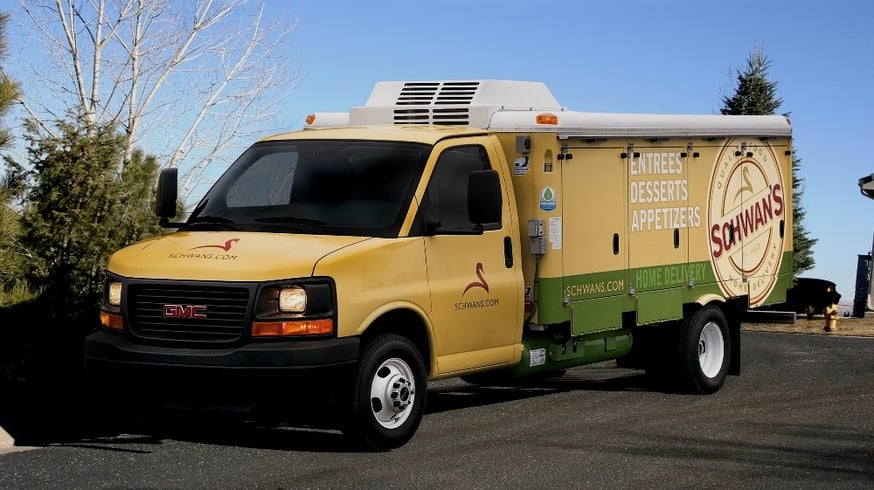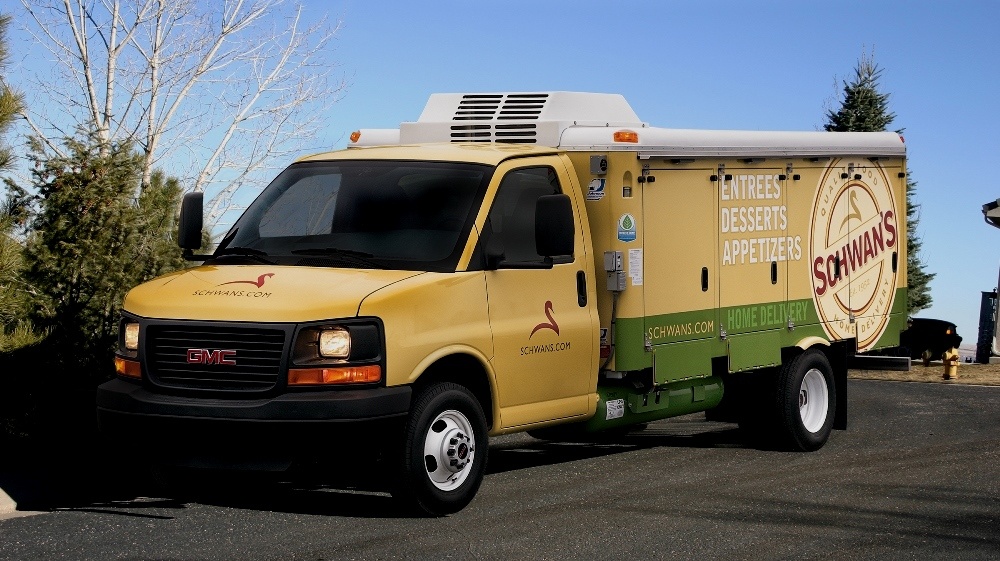
Heller Search: How did you hear about the CIO opportunity at The Schwan Food Company? Were you conducting a job search?
 Kathy Persian: I wasn’t actively looking. I was happily working for Sports Authority in Colorado as CIO & SVP of eCommerce and Business Transformation when I received a note on LinkedIn from someone that I used to work with. A recruiter from Schwan had contacted him about the role, and he thought of me. He recommended that I connect with this recruiter to learn about the opportunity. I wasn’t interested at first, but I always follow through on these types of connections to hear more about what is happening in the industry as well as to potentially connect someone else as appropriate. There is always the chance that I can connect the recruiter with someone in my network, and by doing so, help advance their career.
Kathy Persian: I wasn’t actively looking. I was happily working for Sports Authority in Colorado as CIO & SVP of eCommerce and Business Transformation when I received a note on LinkedIn from someone that I used to work with. A recruiter from Schwan had contacted him about the role, and he thought of me. He recommended that I connect with this recruiter to learn about the opportunity. I wasn’t interested at first, but I always follow through on these types of connections to hear more about what is happening in the industry as well as to potentially connect someone else as appropriate. There is always the chance that I can connect the recruiter with someone in my network, and by doing so, help advance their career.
Why weren’t you interested?
First, I was quite happy at Sports Authority. Also, I wasn’t sure it would be right for me at that time because of the way the role was structured. The CIO was reporting up through finance with no direct line to the CEO. While this isn’t necessarily an issue, it sometimes speaks to the importance of the technology role in the organization. Previously, I had reported to the CEO in all of my CIO roles, which positioned technology as a key capability within the organization.
When I explained this to the recruiter, she encouraged me to at least have the conversation and see what happens. I agreed. I sat down for an informal conversation with the chief human resources officer.
How did those meetings go?
I was blown away.
I remember seeing the iconic yellow Schwan food trucks delivering food to homes in my neighborhood when I was growing up. That was what I knew about the company at the time. Doing my research before the meeting, I learned that the company is much broader. There is a large consumer brands business that owns Red Baron, Freschetta, Tony’s and Bon Appétit pizzas, Mrs. Smith’s and Edwards pies, Pagoda Asian-style snacks and many others. There is also a food-service business that supplies schools, convenience stores, hospitals, and other institutions.
 Then, in these meetings, I learned all about the business transformation that was taking place at Schwan. They were starting with culture and people, which to me was impressive. I felt that where The Schwan Food Company was on its journey at that point in time was a really good match for my experience. I was suddenly very interested.
Then, in these meetings, I learned all about the business transformation that was taking place at Schwan. They were starting with culture and people, which to me was impressive. I felt that where The Schwan Food Company was on its journey at that point in time was a really good match for my experience. I was suddenly very interested.
What else made this CIO opportunity attractive to you?
Honestly, it was meeting the other executives, other team members, seeing the level of talent here, and their openness to change. It got me more excited about coming in and being a part of the leadership team taking the company to the next level. I wanted to help this company use technology as a competitive advantage as it moves into a period of growth.
What was Schwan looking for in their new CIO?
They were looking for core IS delivery capabilities and a good cultural fit. Will this person be a strong member of the team? Will they help bring the cultural journey to the rest of the team? We spent the majority of discussions talking about cultural fit and advancing the culture throughout the entire company.
Why do you think Schwan concluded that you were a strong cultural fit?
That is a really great question. When they interview candidates, I think they listen for how you tell the stories of your career, how you describe your experiences. Do you talk about just the technology and the results, or is teamwork important? Are you saying “I” or “we”? Do you react with a sense of urgency?
How did you prepare for your interviews?
I thought through what would be my answers to the classic interview questions about my strengths and my areas for development. I did a tremendous amount of research on Schwan and the food industry, which was difficult because it is a privately held company. I was able to reach into my network and talk to a few people I knew who had done business there, just to learn more than I could on their website and business news sites.
How did you prepare to start your new role?
I reviewed a lot of material from Gartner and others about planning your first 90 days and then I started framing up my 30-60-90 day plans for the things that I knew I needed to do, and what I wanted to accomplish.
Who do you report to?
The CEO. The recruiter was right. There was flexibility on the reporting structure.
What is the size of your IT organization?
There are 160 employees in IT at the company, and we work with an offshore provider for overall support.
From day one, how did you learn about the business?
We are very “on purpose” here, so I immediately embarked on an assimilation process that was all about learning as much as possible about the business and how we operate. In the first couple of months I met with key stakeholders, team members, and visited many of our facilities. I also did a few “ride-alongs” with our home-delivery and direct-store-delivery personnel. I think that, as a CIO, you learn the most from the people on the front line who depend on the technology every day.
We have a product innovation group, which includes our food scientists. There was a new leader who was on-boarding into that group at the time, and so I had the opportunity to co-assimilate with her and do a deeper dive into the process for developing new products. That was very informative.
Did you find that anything in IS that was "on fire" and needed to be dealt with right away?
Thankfully, no. The systems were stable and secure.
Since you started your role, what have you and your team been working on?
We have put structure around three strategic initiatives in IS. These have essentially formed our marching orders.
First is road-mapping — working with our business partners to understand their strategic plans, where they need to be in three to five years, what capabilities are needed, and how IT will enable those capabilities.
Second is simplification — where can we simplify our processes and our technology?
And the third initiative is operating excellence. Every part of the company depends on IS for stability and efficiency, so this is about making sure we know the state of our systems at all times, our uptimes, all the basics of running IS. And working to raise the bar.
Have you made any notable organizational changes?
We recreated an enterprise architecture function that had languished, and we also created a team around digital.
Can you describe your digital team?
As a company we have three distinct business units, and there is digital in each: mobile, apps, websites, etc. The job of my digital team in IS is not to facilitate the overall digital business strategy, but bring together the digital aspects of the enterprise to drive synergies and innovation.
What is the most enjoyable aspect of everything you are working on right now?
The road-mapping initiative is exciting for me because we get down to where technology really brings to life what we want to do as a business. Others may find that boring; I find that exciting.
What would you say are the keys to success in the first 100 days?
The most important piece for me was listening. There is always going to be pressure to prove yourself and to start doing something. If you don’t take the time first to listen all the way around the organization, you may act on something that isn’t going to make a difference. Don’t act too soon, but when you are ready, act with urgency.
If you were granted a ‘redo’ on your first 100 days, what would you do differently?
You can never spend too much time out in the field.
What new consumer technology do you find exciting personally?
For me it’s the Internet of Things. I know it’s a buzzword, but I think there are a lot of cool things that can happen there, like things that can make the home more efficient. There are more security issues there, but we are a more security-conscious population now. On Amazon.com, I have Alexa in my basket, but I haven’t bought it yet.
Once you buy it, what do you think your first voice command will be?
“Alexa, watch Minnesota Wild!” We’re big hockey fans here.
How do you know when your IT organization is succeeding?
There is stuff you can measure and stuff that you can’t. Are you meeting service levels and are you delivering on time and on budget? Those are measurable.
The other side is qualitative, what you hear when talking with your business peers. What language do they use when describing the service they receive from IS and our partnership. Rather than hearing, “I want to use this app. When can you make it happen?” I like it when I hear, “This is what I want to achieve in my area of the business. How can we work together to accomplish it?” It’s moving the perception of IS from order takers to being part of the business.
What advice do you have for IT executives thinking about moving to a bigger role and a bigger challenge?
Do it for the right reasons. Too many times, we seek something new and we don’t pay attention to the red warning lights flashing inside our heads. If you want the next and bigger thing, be clear on why you want it. Know what the right fit is for you, and stay true to that.
About Kathy Persian
Kathy Persian is senior vice president and CIO at The Schwan Food Company, a privately held business based in Minnesota that manufactures and markets quality foods through home-delivery, retail-grocery and food-service channels. The company employs approximately 12,000.
Prior to joining The Schwan Food Company, Persian served as senior vice president of business transformation and CIO for Sports Authority, where she was responsible for corporate strategy development, the information services team, e-commerce, and enterprise program and process capabilities. Earlier, she served in information technology leadership roles at Supervalu and Best Buy. Persian received her bachelor’s degree in business management from the College of Saint Benedict in St. Joseph, Minnesota.

Written by Steve Rovniak
Steve Rovniak served as Executive Director, Marketing and Media at Heller Search Associates from 2012 to 2023.



